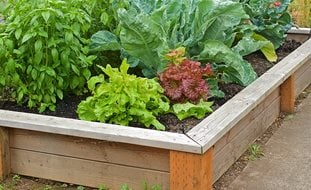How to Grow Potatoes
The steps for planting, harvesting and storing potatoes at homeHave you ever grown your own potatoes? If not, you might be surprised how easy it is! Potatoes can be grown in the ground, in raised beds, or in large containers. Many gardeners prefer raised beds because of the good drainage and soil control. Simply choose a sunny spot, provide loose, fertile soil and regular watering and you can have your own homegrown potatoes.
On this page: Basics | How to Plant | Harvesting | Storing | Care | Troubleshooting & Tips | FAQs
On this page:
- BASICS
- HOW TO PLANT POTATOES
- HARVESTING
- STORING
- POTATO PLANT CARE
- TROUBLESHOOTING & TIPS
- FREQUENTLY ASKED QUESTIONS
BASICS
Botanical name:
Solanum tuberosum
Hardiness Zones:
Grown as a cool-season annual in most zones; can be grown year-round in frost-free areas
Soil:
Loose, well-drained, fertile soil with pH 5.8–6.5. Adding compost improves soil structure and provides a slow-release source of nutrients.
Sunlight:
Full sun (6+ hours per day)
Water:
1" per week; consistent moisture is key
Days to maturity:
70–120 days, depending on variety and climate
Popular varieties:
Yukon Gold, Red Norland, Kennebec, Russet, Fingerling
HOW TO PLANT POTATOES
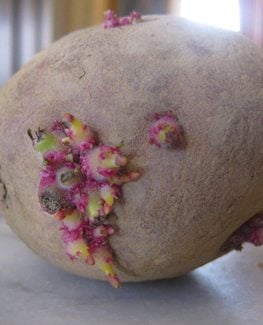
Photo by: Kevin Lee Jacobs.
Step 1: Choose Seed Potatoes
The first step in planting potatoes is choosing high-quality seed potatoes. These aren’t actual seeds, but small, whole potatoes or chunks of larger ones that will sprout into new plants.
Certified seed potatoes from a garden center, farm store, or online supplier are guaranteed to be disease-free, unlike grocery store potatoes. Many of the potatoes purchased in grocery stores have been treated with sprout inhibitors to extend their shelf life and aren't ideal for growing.
If your seed potatoes haven’t started sprouting yet, set them in a warm, well-lit area (like your kitchen counter or windowsill) for a few days. This process, called chitting or pre-sprouting, encourages early growth and can help you harvest potatoes a bit sooner.
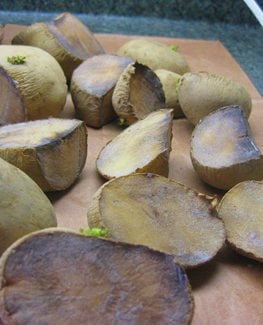
Photo by: Kevin Lee Jacobs.
Step 2: Prepare and Cut Your Seed Potatoes
Once your seed potatoes have sprouted, it’s time to prep them for planting. If your seed potatoes are small (about the size of a golf ball) you can plant them whole. Larger potatoes should be cut into smaller pieces.
Using a clean, sharp knife, slice each large potato into chunks, making sure each piece has at least 1 to 2 “eyes” (small dimples or buds where sprouts emerge). These eyes will be where the stems and leaves of your potato plants form.
After cutting, let the pieces cure for 3 to 5 days in a warm, dry spot that is out of direct sunlight. This helps the cut surfaces callous over, which reduces the risk of rot once they’re in the ground.
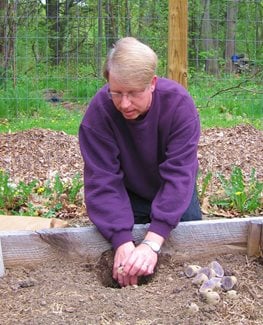
Photo by: Kevin Lee Jacobs.
Step 3: When and How to Plant Potatoes
Aim to plant your potatoes about 2 to 4 weeks before your last expected frost, when the soil temperature reaches at least 45°F. In warmer climates, that might be February; in cooler regions, it’s often March or April. Gardening expert Margaret Roach notes that if planted too early, seed potatoes can rot in cold, water-logged soil.
To plant, dig a 6-inch-deep trench or hole in loose, well-draining soil. Place each seed potato piece cut-side down, with the eyes facing up, spacing them about 12 inches apart in all directions.
Sprinkle a small amount of low-nitrogen, high-phosphorus fertilizer into the trench to encourage root and tuber growth. Cover with 2 to 3 inches of soil and water well. As the sprouts grow, you’ll gradually fill in more soil.
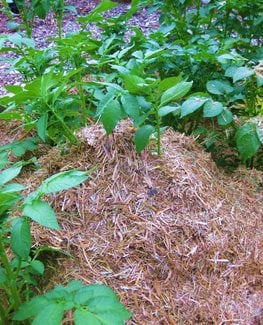
Photo by: Kevin Lee Jacobs.
Step 4: Hill Around the Plants
When the sprouts reach about 6 to 8 inches tall, mound soil, chopped straw, or shredded leaves around the base of each plant, covering the lower half. Repeat this "hilling" process every time the plants grow another 6 to 8 inches, building up a gentle hill about 12 to 18 inches tall over time. Stop hilling once the plants begin to flower.
Why is hilling important? Potatoes form along underground stems, not roots. More coverage means more potatoes. Hilling also protects tubers from sunlight, which can turn them green and make them unsafe to eat.
"Potaotes are formed along little stems called stolons. Those stolens will only appear on parts of the plant that are buried underground. The more you can bury the plant, the more potatoes you will have." Kevin Lee Jacobs, How to Hill Potatoes video.
HOW TO HARVEST POTATOES
You can begin harvesting baby potatoes about 2 weeks after the plants flower. Gently dig around the base of the plants and pull out a few small tubers without disturbing the rest of the plant.
For a full harvest, wait until the vines turn yellow and die back; that’s your sign the potatoes have matured. Carefully dig up the tubers with a fork or your hands, being gentle to avoid bruising the skins.
Pro tip: Gardening expert Kevin Lee Jacobs recommends not washing them right away, but letting them dry for a few hours on top of the soil or in a shaded spot. Then brush off the dirt before storing. This toughens the skins and prepares them for storage.
HOW TO STORE POTATOES
After harvesting, allow your potatoes to cure before storing. Spread them out in a cool, dry, dark place with good air circulation, like a shed or covered porch, for about 1 to 2 weeks. This toughens the skin and helps prevent rot.
Once cured, move them to a cool (around 40–50°F), dark, and humid location, like a basement, cellar, or unheated closet. Keep them in paper bags, cardboard boxes, or mesh bins. Avoide plastic containers or bas which can trap moisture.
Check stored potatoes regularly and remove any that are soft, shriveled, or sprouting.
POTATO PLANT CARE TIPS
Once your potatoes are planted, keeping up with consistent care will help maximize your harvest. Here are a few key tips for healthy, productive plants:
Mulching:
To retain moisture and block light, apply a layer of chopped straw, shredded leaves, or compost around the base of the plants. This also helps reduce weeds and improve harvest quality.
Watering:
Potatoes need about one inch of water per week, especially once they begin flowering and forming tubers. Keep the soil consistently moist but not soggy. Uneven watering can lead to cracked or misshapen potatoes.
Fertilizer:
At planting time, apply a low-nitrogen, high-phosphorus fertilizer to promote root growth. Avoid high-nitrogen fertilizers, as they’ll boost foliage at the expense of tubers. Midseason, side-dress with compost or a balanced fertilizer if plants look pale or weak. The University of Minnesota Extension notes that potatoes require more fertilizer than other vegetables.
Pests and diseases:
Watch for common issues like Colorado potato beetles, aphids, flea beetles, and leafhoppers. Diseases may include early and late blight, scab, and blackleg. Rotate crops yearly, keep foliage dry when possible, and remove any infected plants promptly to reduce spread.
TROUBLESHOOTING AND GROWING TIPS
Even with good care, potatoes can run into a few common problems. Use these tips to prevent issues and keep your crop healthy all season long.
Common Mistakes to Avoid
- Not hilling enough: Exposed potatoes turn green and become inedible.
- Overwatering: Can lead to rot, especially in heavy soil.
- Planting too early: Cold, wet soil can rot seed potatoes before they sprout.
- Planting treated grocery store potatoes: These often won't sprout and may carry disease.
Preventing blight:
Early blight is more common and causes dark leaf spots and gradual decline, while late blight can rapidly destroy foliage and tubers, especially in wet, humid weather. To prevent both, avoid planting potatoes (and other nightshades like tomatoes or eggplants) in the same spot more than once every 3 years. Remove any volunteer plants from previous seasons, and give your potatoes plenty of airflow. (Learn more about early and late blight from the University of Connecticut.)
Crop rotation:
Potatoes should be part of a rotation plan. After growing potatoes, plant legumes or leafy greens in that spot the following year to rebuild soil nutrients and break pest cycles.
Green potatoes:
Exposure to light causes potatoes to turn green and develop solanine, a toxin. Always keep tubers well-covered with soil or mulch. If you find green spots, cut them away before cooking—or discard the potato if most of it is green.
Deep planting option:
If you want to skip hilling, plant your seed potatoes 8 to 9 inches deep. This method reduces the need for additional soil layering, but sprouts may take longer to emerge and yields may be slightly lower.
FAQS ABOUT GROWING POTATOES
Can I grow potatoes from grocery store potatoes?
It’s not recommended. Most store-bought potatoes are treated with sprout inhibitors and may carry diseases. For best results, use certified seed potatoes that are guaranteed to be disease-free and suitable for planting.
How deep should I plant potatoes?
Plant seed potatoes about 6 inches deep in loose soil. If you don’t plan to hill the plants later, you can plant them deeper, around 8 to 9 inches, but expect a slower start and possibly smaller yields.
What’s the best fertilizer for potatoes?
Use a low-nitrogen, high-phosphorus fertilizer to encourage strong root and tuber growth. Too much nitrogen will result in lots of leafy growth but fewer potatoes.
Can potatoes grow in shade?
Not well. Potatoes need full sun, at least 6 to 8 hours of direct sunlight per day, for healthy growth and good yields. Too much shade can lead to weak plants and poor tuber development.
What causes scab or hollow centers in potatoes?
Scab is a common bacterial disease often caused by high soil pH. To reduce risk, keep soil slightly acidic (pH 5.8–6.5) and avoid planting in dry, alkaline conditions. Hollow centers (also called "brown heart") can result from uneven watering or overly rapid growth in some varieties.
Can I grow potatoes in containers?
Yes! Potatoes grow well in containers or grow bags if you use loose, fertile soil and a container that’s at least 16 inches deep. Keep in mind that containers dry out faster than in-ground beds, so you’ll need to water more frequently. Yields may be smaller, but it’s a great option for small spaces.
How long do potatoes take to grow?
It depends on the variety and conditions. Most potatoes take 70 to 120 days from planting to maturity. You can harvest small "new potatoes" as early as 10 weeks after planting, but full-size tubers usually need more time and are ready once the vines die back.
ABOUT THE AUTHOR
Linda Hagen is a writer and content coordinator at GardenDesign.com, where she combines firsthand gardening experience with expert insights. Based in Southern California (Zone 9B), she’s passionate about vibrant, pollinator-friendly gardens and believes the best lessons come from a trial-and-error approach to growing .



